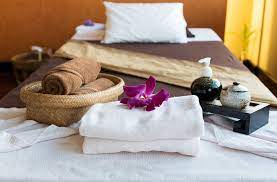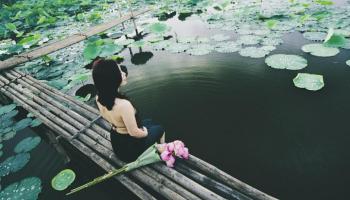The “wellness” trips put health at the center of travel experiences, with activities that revitalize the body and nourish the mind in search of a better quality of life. All options to take care of yourself physically, psychologically and spiritually
Who says vacations have to be unhealthy?
The growing popularity of health and wellness retreats is testament to the growing interest in physical and spiritual care, even on vacation. Whether it’s a classic spa getaway, raw food cooking classes, a luxury yoga retreat, or a trekking expedition in Patagonia, these are all great excuses for a healthy vacation.
In the world, wellness tourism is, according to the Lonely Planet tourist guide, the fastest growing sector of the industry with an increase of 10% this year. The United States is the largest national market for wellness tourism, although China is making big profits.
A change in mentality
Travelers who choose this type of travel are those who perhaps feel pressured by their professional lives, live in an intense daily maelstrom, and seek to overcome this intensity. It is a change in mentality that allows the traveler to stop to contemplate and enjoy of leisure moments and spaces, eating well and changing travel habits to reconnect with oneself and be able to experience vacations in a different way.
There are so many new combinations of travel destinations that focus on ‘healthy’ experiences, attracting both men and women, at increasingly affordable prices,” explained Susie Ellis, CEO of the Global Wellness Institute (GWI) about the growth of this category.
World travelers take around 586 million wellness trips each year, according to the Global Wellness Summit. In fact, the wellness tourism niche encompasses 15% of global travel, second only to cultural tourism. Wellness travelers spend approximately 130% more than the average traveler.
Understanding rest as a central axis is key to shedding hourly pressures, compulsory visits, and not being aware of mobile devices and social networks, they favor good enjoyment and an integral well-being that is complemented by the preferences of each traveler: outdoor activities, light-impact exercises, healthy eating, cultural impressions or non-traditional ecological getaways.
Holistic well-being

Travelers who choose it do so in order to decontact themselves physically and emotionally, escape routine and its frenzy, coin life experiences as well as photographs. They seek – without a doubt – to merge during the trip with the place and its ways so that well-being is holistic.
Food for the body, mind and soul
The definition of healthy eating encompasses many styles of cooking. However, what the accommodations or experiences that offer it have in common is the indisputably delicious dining experience, as wellness travelers do not sacrifice taste for health.
At present, wellness tourism places great importance on the healing and healing of the bodies from food. In some places, organic kitchens are so cool that guests can choose the stuff themselves. There, nutrition experts educate guests on how to nourish the body and soul through a balanced diet.
At the same time, these new modalities often motivate the traveler to seek to stay or at least have knowledge of places where he can eat well and healthy. Sometimes one ends up traveling and having little time to eat. impairing their healthy eating habits. The movement of ‘conscious travelers’ seek to enjoy the moment of travel without neglecting personal care.
Farm-to-table

Farm-to-table food is another culinary wellness trend, and many lodges bring it to life perfectly. The properties or farms that function as lodgings demonstrate the generosity of their gardens, bakery, butcher and dairy in the meals that they serve to those who visit them.
“Accommodation of this type has a very varied offer that includes vegan, vegetarian, detox or customized menus in their restaurants; they have open spaces, where they prioritize light and the appropriate setting to contribute to the traveler’s enjoyment,” said Cartasegna.
Exclusive experiences based on the exploration of the senses
At resorts offering spa treatments, exclusive experiences stand out. Often times, these unique treatments stem from the culture or natural surroundings of the destination. “The accommodations that predominate for this category are those that include spa services, recreation spaces, personalized attention and beauty treatments.
From therapeutic massages to phytotherapies, which treat conditions with medicinal plants, they are some of the most innovative treatments in the field. The latter uses more than 40 plants to create personalized herbal teas to achieve a variety of goals, including relaxation, digestion and purification of the body.
Some rituals begin with full body scrubs with traditional soap suds, then massages with soap or oil foam, and finally hot stone massages and steam baths. Well-being based accommodations use pastel colors for their ambience that promote the concept of clarity and tranquility. From the beginning, they invite guests to begin to feel that connection with tranquility.
Unleash your mind and body with inspiring yoga trips, meditation breaks, and fitness vacations
The best physical options combine activity and nature: two keys to wellness tourism. Yoga classes given by experienced teachers who design specific programs that
They blend discipline with meditation for guests based on their goals. They offer different styles of yoga, including techniques for releasing psychic energy and focusing on breathing.
Adrenaline sports are popular with wellness travelers

Water activities like surfing, rafting and diving are booming and other adventures like bike rides or running also fuel the adrenaline, setting the stage for deep relaxation afterward. Physical activities are not just for adults. Families love the combination of movement and the great outdoors. Cycling is a favorite for young and old.
Thermal waters for therapeutic and relaxation purposes

Thinking of hot springs and pools full of warm mineralized waters is often synonymous with relaxation and tranquility. It is not a wrong concept, but to this must be added something else: thermal waters for therapeutic purposes.
The hot springs are ideal for protecting and restoring health. They have energetic factors such as powerful ionization, mineralization, radioactivity, gases, and PH variations. They improve the skin, produce rest, transmit energy and make the visitor feel renewed inside and out.

